Submitted by Tarun Bhasin
Urban Design's Reckoning: From Clientelism to Deliberate Action
India Architecture News - Jun 28, 2020 - 13:37 4318 views
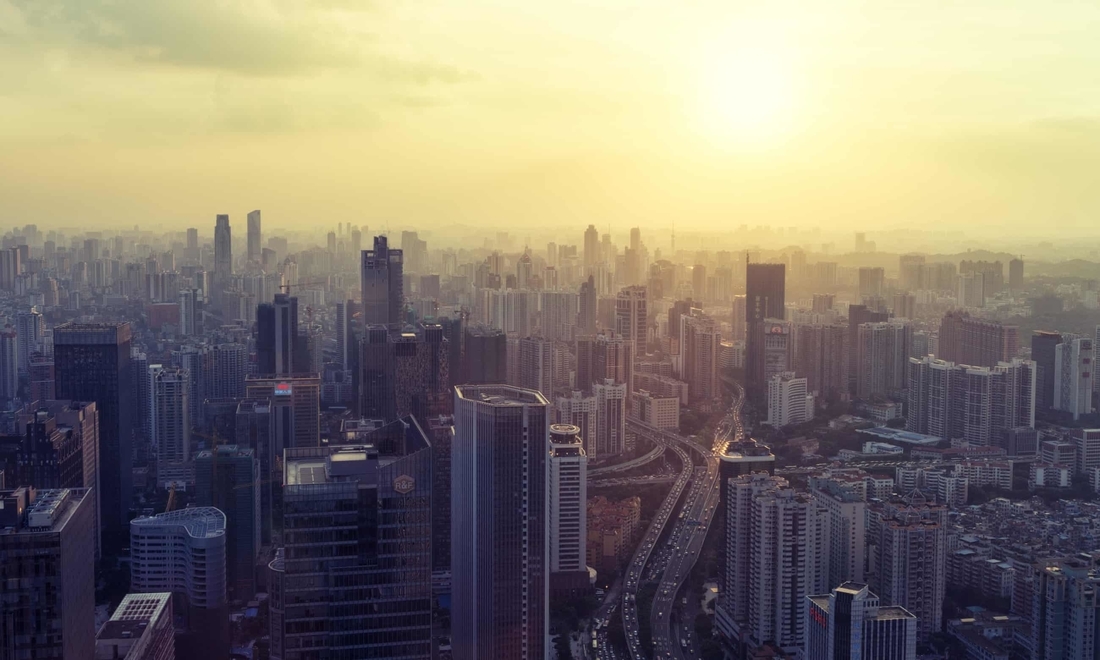
How Urban Design Practice Relates To Spatial Justice And Its Embedded Dimensions
Allowing Each Individual To Pursue His/Her Ambitions Will Lead To Social Benefits, Which Adam Smith In The Wealth Of Nations Also Termed As The 'Invisible Hand.' The Statement Drew From His Observations On How Capital, Labour, The Act Of Production, And Consumption Had Mostly Behaved Historically. The Statement In Isolation Made Sense For The Longest Time. (Rasmussen, 2016).

Image Credit: Warsaw, after World War II, was reconstructed by reimagining its 18th Century paintings from the time period of the First Industrial Revolution, since its urban fabric structurally remained the same, The Guardian
The act of production is dependent on the availability of available labour, resources, and time-value efficiency of production. The act of consumption/sales depends on the buyer's willingness to buy the product after comparison with similar products in a free market based on cost and quality. Each individual strives to maximize his production and sales or attain the best product in the market. It was natural that this ‘social contract’ between the producer and the public would ultimately improve the quality of the product, and result in the innovation of markets and production mechanisms. (Collins, 1988)
During this time, the aspect of production and consumption remained separated from participation in public space. That is to say, the objects in production-consumption and their producers (butcher, brewer, carpenter, weaver, and similar actors) did not influence the use of public space. They did not demand public space to take shape in a particular manner. Thus, the systems of production did not ascertain the validity of public space. Planning was in the hands of oligarchs or the then forms of governance. City centers became invited spaces for everyone else. Only public infrastructure like cathedrals, canals, aqueducts, squares, thoroughfares, and gardens, under the patronage of oligarchs, influenced public space. (Rubin, 2020)
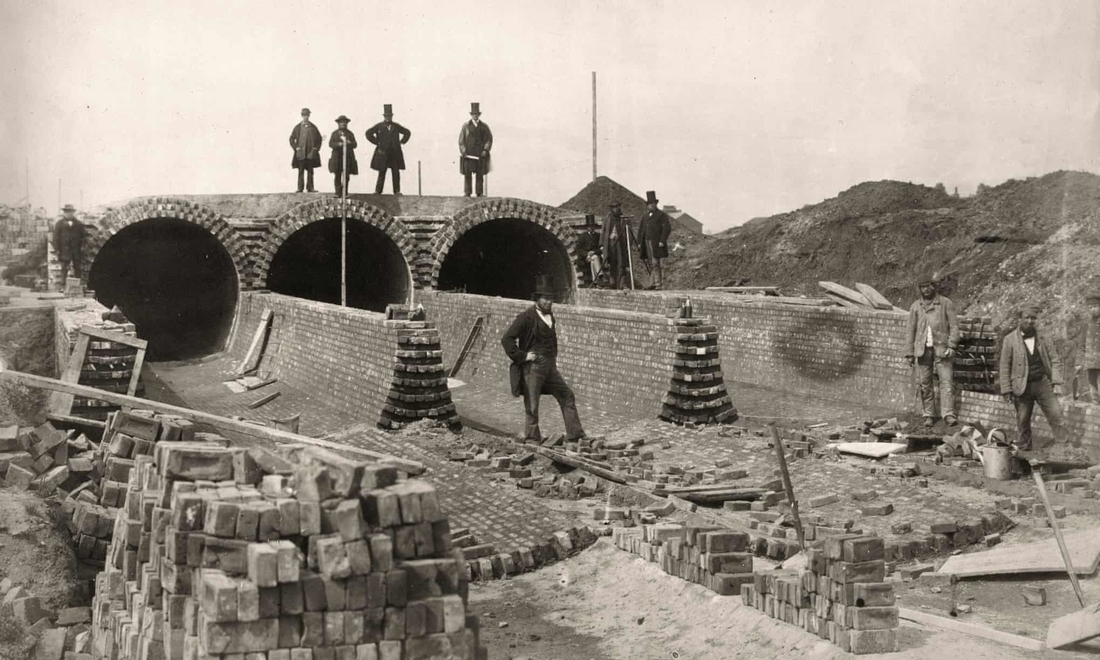
Image Credit: Joseph Bazalgette’s sewage system next to Thames, constructed at the end of First Industrial Revolution, prepared it to absorb the growth of the Second Industrial Revolution, and remain the foundation for the efficient functioning of London's urban fabric to date, The Guardian
However, production-consumption systems did provide a social and economic structure to the said places influencing public life and allowing a form of recognition and participation between the influencer and the influenced, in this case, the producer and the consumer. It created a form of 'informed consent' that allowed production systems and producers to occupy the public sphere and shape public life. It projected production and consumption knowledge as part of the 'Truth' of proactive knowledge production of cities and their continuous ongoing process of adaptation to changes and innovations in time. The other part of the 'Truth' was the agreed-upon need for reconciliation and reparations to the public (as consumers). Their role as an equal participant in the system that was then shaping urban life and the meaning and identity of cities was systematically omitted. (Lefebvre and Smith, 1991)
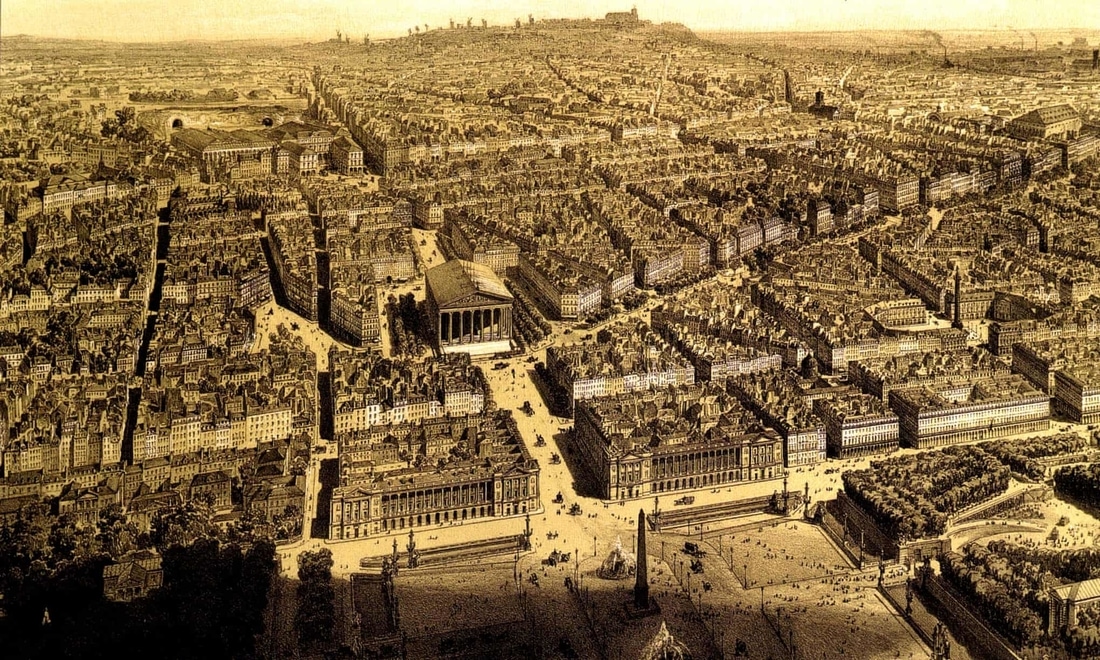
Image Credit: Georges-Eugène Haussmann's transformative plans for Paris in the middle of the Second Industrial revolution are still a topic of controversy for its successful end result, but also for its processes that caused the displacement of millions, The Guardian
This omission happened with the First and Second Industrial revolutions and automobiles' invention, use of oil, coal, electricity, concrete, steel, and modern agriculture. Suddenly with the change of scale of production and accumulation of capital, the form of capitalism that soon emerged was 'monopolies.' These forms of production systematically suppressed proactive knowledge production by issuing 'patent rights.' They limited the public to learn and adapt to the changes on their own. The move created a dependency on said monopolies to accommodate their inventions in the public sphere. It allowed these monopolies to intervene in the process of planning directly. Slowly but steadily, monopolies excluded the public from the same decision-making processes of which earlier it was a more significant stakeholder than capitalism. (Mokyr, 1999)
Monopolies created modernism’s obsession with cities as economic entities, as engines of growth and development. Cities became the places of economic activity or exercise of power; and places of residence for those engaged in these activities. It created a system's thinking about how labour and flow of capital impact a city's processes. Its core idea is that capital, to create wealth, expands and operates in different circuits, consolidates labour, and later switches into the built environment. This idea dominates the domain of real estate. People use land value and investment as a means of growing their social capital, businesses, and resources. (Parnell, 2016)
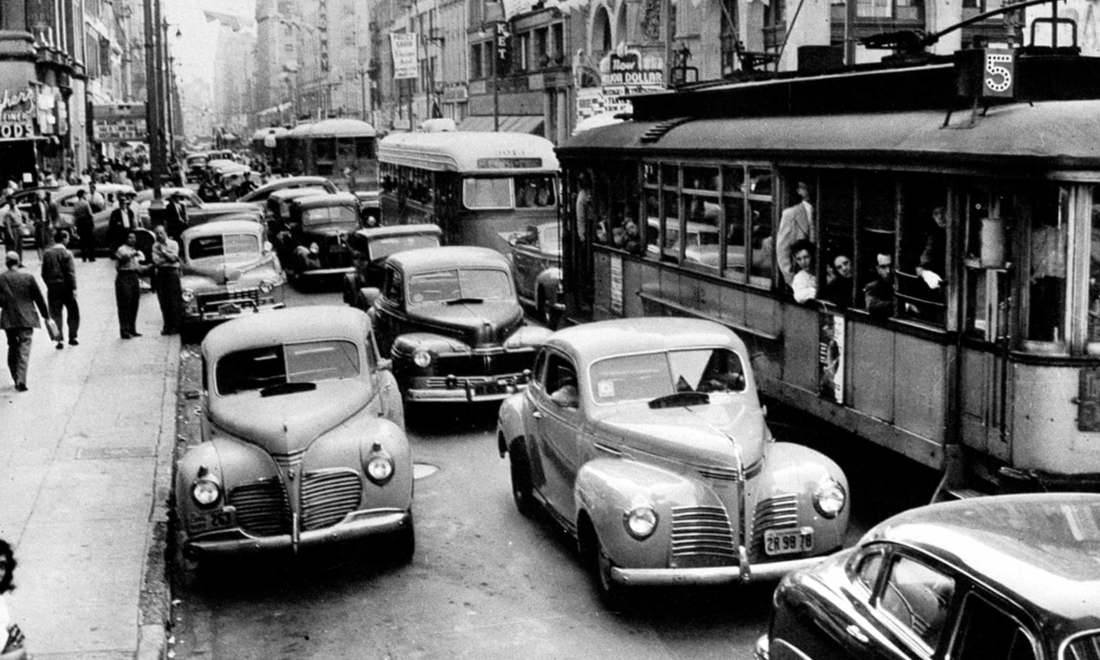
Image Credit: Los Angeles evokes powerful images from the Second Industrial Revolution right into World War II, with automobiles taking over the streets and public life, which are considered one of the most defining moments in the planning of 20th Century America, The Guardian
This thinking reduced the reconciliation or reparations provided to the public since they were no longer considered informed or knowledgeable and thus were passive consumers that were replaceable and displaceable. The exclusion over generations reduced public understanding of the processes of making of the public sphere. It limited public knowledge and information and omitted the notion of 'informed consent' from public discourse. It severely hampered the capability and accessibility of common man to influence, shape, or by any form give meaning to or interpret public space. With time, it reduced their participation in public life and diminished their recognition in the meanings given to public spaces. (The RSA, 2010)
People without access to opportunities had to settle voluntarily or by necessity, in parcels of land not suitable for human habitation because of environmental or infrastructural vulnerabilities. They began creating a separate circuit- the 'informal' economy – composed of a class of people that are no longer agrarian, no longer reliant on land, and hence relied on socio-urban mobility to sell labour for a living. Everything had to be paid for in cities. Low and uncertain wages created harsh situations for the poor and vulnerable. In turn, by living in abysmal living-working conditions and accepting poor wages, the poor and the vulnerable subsidized the city- while struggling towards organization and house-ownership. It was an act of deliberate and systematic injustice meted out by monopolies and is in effect to date. (Marx, 2006)
Architecture and planning were seen as two pivots to actualize the will of money and power in public life through spectacular realizations. Each successive fold distanced the civil societies further from their discourses. Here strategies were choices of non-neutral curators whose authorship and autonomy remained unexplained. (Schmiechen, 1984)

Image Credit: The struggle against the proposal to build a road through Greenwich Village in 1955 over the decades became a testament for 'Right to the City' for New York as the world prepared to move into the Third Industrial Revolution, The Guardian
Why is it important to know all this? Because this is precisely the moment when Urban Design as a deliberate, coordinated action was born to counter the production methods explained above. The spectacular takedown of Robert Moses by Jane Jacobs halted the construction of a highway (oil, steel, concrete, automobiles?) leading to Manhattan, to protect her neighbourhood and its community from being displaced or having their access to the ocean cut-off. (Wainwright, 2017)
The story reveals a state of shock for practitioners, presenting a reality where the architecture and planning profession as an external agent and its knowledge in the situation failed catastrophically. It revealed how an understanding of their own lifestyle drove practitioners' actions and thought, a position of privilege. Furthermore, they created emotional, economic, and social luxuries, out of wishful thinking, that the subjects of their design could not afford at all. (Paletta, 2016)
The pace of the normative processes, means of engagement, the establishment of relationships, and frameworks of use - the nuanced aspects related to their design - far outweighed the importance of their design. Reflexivity and research began at the point of failure of the limits of professional knowledge and critical breaking down of the practitioners' identity. It marked the moment beyond which their positionality and meaning were in question. (Paletta, 2016)
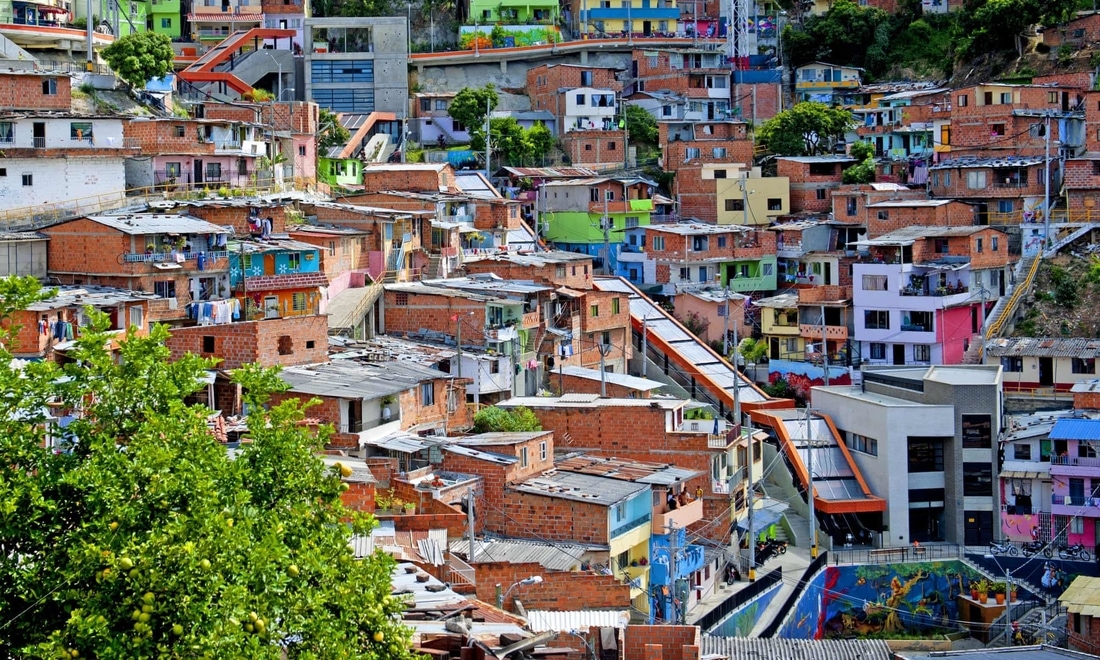
Image Credit: The surreal, arduous and painfully negotiated urbanism of Medellin from 1950-to date is the most dynamic critique on the notions and methods of Urban Design with great hope for its people and their future embracing the Third Industrial Revolution, The Guardian
Thus, we can say that Urban Design as a discourse came up as an investigation into the language of cities projected by the specialists of capitalism. It came up to challenge their correctness, and insert the images and emotions of people and public events back into the negative images of specialists and rare knowledge forms amassed by monopolies. Urban Design came up as a process of deliberate, organized action to allow the concept of architecture and planning to remain alive as an essential discourse in the hearts of the public. It came up during the age of rapid urbanization, where the public was losing insight into these discourses and their consequent knowledge production. It acted as a tool to harness the public's potential in the spaces they inhabited as individuals and communities. (Purcell, 2013)
Urban Design, not architecture or planning, is the most political among all arts. It legitimizes the process of construction of private space and its effects on its immediate context within the domains of social, economic, and political sciences. It is the tool to satisfy individual needs and produce public goods in the form of democratic spaces that enrich and inform public participation and life. It increases the total value added to cities in generating each action or investment; thus, enhancing the total wealth of cities and the public's well-being. (Purcell, 2002)
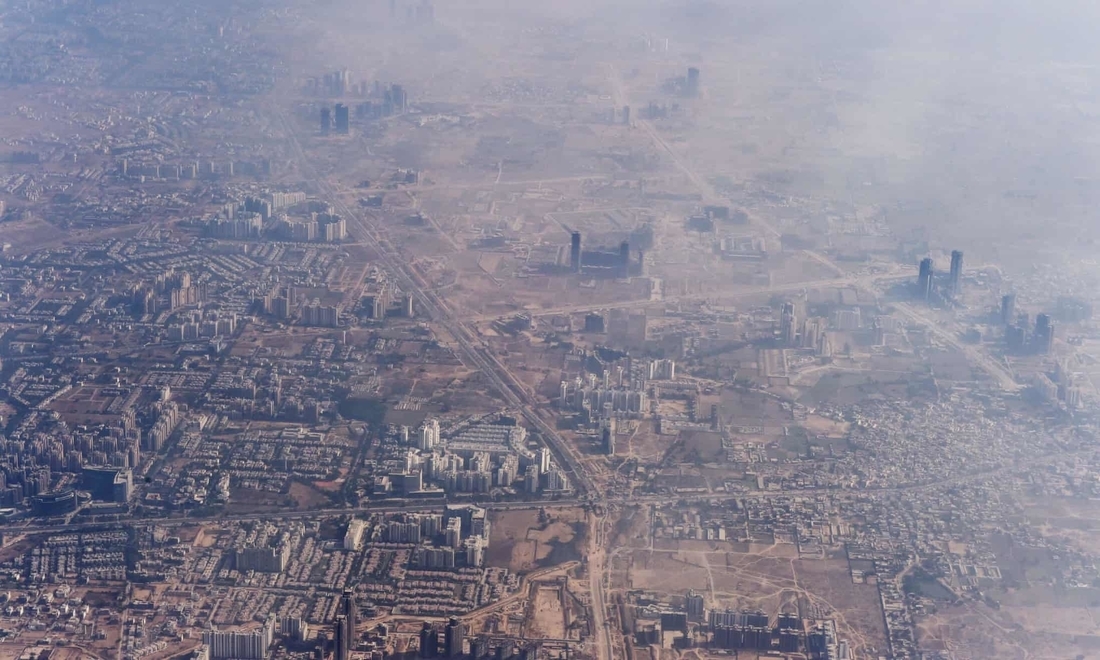
Image Credit: New Delhi represents one of the most deeply rooted structural inequalities resulting from its colonial roots that continue to plague its efforts for a sustainable future making it one of the worst hit cities in the world during the COVID-19 pandemic, The Guardian
The same (the reverse) is right in its absence. The 'free-market theory' taken from Adam Smith and carried forward by monopolies assumed that any action taken in the present was reversible in the future. The notion incorrectly assumed that cities' shape as accumulated and condensed capital is mainly irreversible. Therefore, cities throughout the world presently face massive ramifications in the form of spatial inequality and inequity. (Purcell, 2002)
Structural inequality has been made apparent in the current COVID-19 crisis after cities and their economies quickly collapsed following an almost global shutdown, causing large reverse migrations. It has revealed how significant populations of the city face 'distributive injustice' that renders them incapable of surviving in the cities. It is primarily a problem generated due to the processes actualized over a century before. The current pandemic also reveals how the dispossessed people allow for the production systems to exist, function, and produce knowledge and change in cities. (Posel and Marx, 2011)

Image Credit: Does the Cybercity of Mauritius is a landmark image of the Fourth Industrial revolution arriving in Africa, or does it exacerbate its existing challenges? The Guardian
However, the historical processes of monopolies did not change the way people communicate with each other and produce knowledge. Their objects of production (textile, electricity, automobiles, steel, concrete, and railways) were forms that influenced the rudimentary physicality of space. The current forms of monopolies (tools like electronics, digital media, internet, and augmented reality, to name a few) influence public behaviour in space. Monopolies now control the way communication takes place, and ultimately are working to control the production of knowledge itself while it is taking place. (Plantin, 2018)
For example, the data and knowledge that Google produces on maps arise from people's participation in public space and sharing of that knowledge with Google. However, Google does not share the profits (and its dividends), technological knowledge, and power with the public while actualizing processes that now shape our cities. We are witnessing the formation of many 21st Century monopolies such as Airbnb with its ramifications on availability of affordable rental space in cities, or Uber with its ramifications of public shared transport. They remain unexplained autonomies and authorships in the design of the public sphere, much like their counterparts of the late 19th and 20th centuries that continue to exist and manifest their power simultaneously. (Plantin, 2018)

Image Credit: Seoul represents one of the few megacity masterplans that successfully reversed urban decay and reclaimed public commons but with many other complications, The Guardian
This struggle of Urban Design is evident throughout history. It is usually about an external agent entering a scenario where the public lacks 'distributive justice' – equity, accessibility or minimum capability to continue surviving or growing in the free-market competition; tries to understand the accumulative effects of the people, their competition and the system at large – in doing so gives recognition and allows means of participation to the dispossessed; takes the decision to deliberately map out the relationships, the costs and benefits of interventions demanded by the public and the ones meted out by the system distributed amongst the public in space and time in a complex geography, thus providing 'deliberative justice;' creates a vehicle, an institution or drives an existing one to ferment political action to bring both the system and the public on table to further their information and understanding of each other with the aim of creating consensus on the issues, thus, providing 'procedural justice' through the notion of informed consent; in doing so, makes the system provide some form of reconciliation and reparation to the public which in itself is a silent admission of ‘Truth’, thereby, providing 'restorative justice;' and ultimately leaves the public with a form, process and ethos of proactive knowledge production that gives them the insight, confidence and dignity to add meaning to public spaces and be an indelible part of ongoing city-wide processes of adaptation in an attempt to provide 'epistemic justice.' (Sheller, 2018)
Today, individual action and free competition are not enough for an already dispossessed public in the face of neoliberal reforms of governance and the diminishing role of Welfare States. Thus, it is essential to remember the birth of Urban Design as that very ‘visible hand’ capable of enforcing direct interventions and setting up efficient systems that validate the incentives and disincentives of individual choices. (LeCavalier, 2019)
Urban Design practice, therefore, is the very form of deliberate, organized action to provide solutions to public spaces that benefit the outcome for some without reducing the conditions for the others. It addresses the conflicting interests of everyone’s underlying actions, guided by the phenomenology of desires, needs, and the will of those affected. A phenomenology developed in correct and adequate representation, and then matched with coherent choices for partial or complete satisfaction. And its role is now more important than ever; with the newer forms of technologies that on one hand can ensure the transparency and non-market collaboration essential to make better choices for well-being, and on the other hand, their newer forms of monopolies that threaten the very processes of knowledge production that are the modalities Urban Design uses to exist and provide justice in the public realm. (Novara Media, 2019)
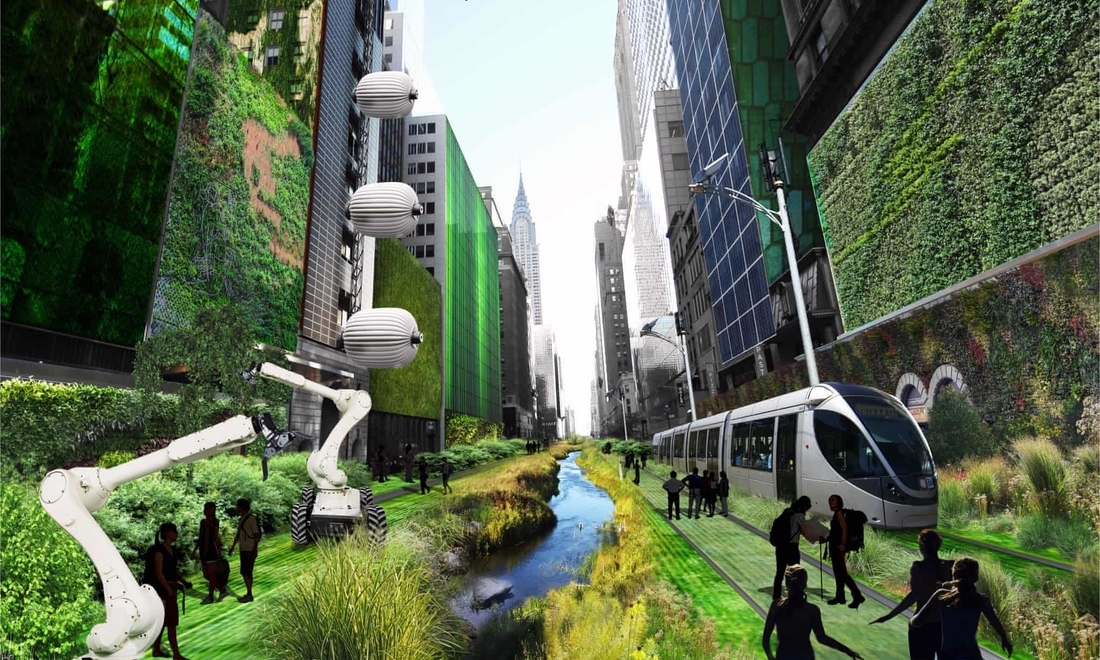
Image Credit: Will we be able to make our cities more inclusive and equitable while grappling with issues of climate change, sustainability and artificial intelligence? The Guardian
Top Image: Shenzhen growing from the size of a village to a megalopolis in just three decades catapulting through the benefits of the Third Industrial Revolution and becoming the most well positioned city in the world to embrace the next one, ©The Guardian
References
Collins, D., 1988. Adam Smith's Social Contract: The Proper Role of Individual Liberty and Government Intervention in 18th Century Society. [online] Business & Professional Ethics Journal, 7(3/4), 119-146. Available at: [Accessed June 28, 2020]
LeCavalier, J., 2019. Modernism's Visible Hand Reveals How Regulatory Governance Has Shaped American Architecture. [online] Architect’s Newspaper. Available at: [Accessed 28 June 2020].
Lefebvre, H. and Smith, D., 1991. The Production Of Space. 1st ed. Oxford: Blackwell, pp.179-180.
Marx, C., 2006. Conceptualising ‘The Economy’ To Make Urban Land Markets Work For The Poor. [online] Urbanlandmark.org.za. Available at: [Accessed 27 April 2020].
Mokyr, J., 1999. The Second Industrial Revolution, 1870-1914. [online] En-econ.tau.ac.il. Available at: [Accessed 28 June 2020].
Novara Media (2019). Fully Automated Luxury Communism. [video] Available at: https://www.youtube.com/watch?v=PugN3t2QvWs&t=3408s [Accessed 12 Jan. 2020].
Paletta, A., 2016. Story Of Cities #32: Jane Jacobs V Robert Moses, Battle Of New York's Urban Titans. [online] The Guardian. Available at: [Accessed 28 June 2020].
Parnell, S., 2016. Defining a Global Urban Development Agenda. World Development, 78, pp.529-540.
Plantin, J., 2018. Google Maps As Cartographic Infrastructure: From Participatory Mapmaking To Database Maintenance. [online] Eprints.lse.ac.uk. Available at: [Accessed 28 June 2020].
Posel, D. and Marx, C., 2011. The Interaction Between Informal Land Markets And Rural-Urban Migration. [online] Urbanlandmark.org. Available at: [Accessed 27 April 2020].
Purcell, M., 2002. Excavating Lefebvre: The Right To The City And Its Urban Politics Of The Inhabitant. [online] Faculty.washington.edu. Available at: [Accessed 27 April 2020].
Purcell, M., 2013. POSSIBLE WORLDS: HENRI LEFEBVRE AND THE RIGHT TO THE CITY. [online] Faculty.washington.edu. Available at: [Accessed 27 April 2020].
Rasmussen, D.C., 2016. The Problem With Inequality, According To Adam Smith. [online] The Atlantic. Available at: [Accessed 28 June 2020].
Rubin, M., 2020. How Pandemic Shattered The Harmony Of Medieval Europe's Diverse Cities. [online] The Conversation. Available at: [Accessed 28 June 2020].
Schmiechen, James A. 1984. Sweated Industries and Sweated Labor. Urbana: University of Illinois Press.
Sheller, M., 2018. Mobility Justice. 1st ed. Verso: Bloomsbury.
The RSA, 2010. RSA ANIMATE: Crises Of Capitalism. [image] Available at: [Accessed 28 June 2020].
Wainwright, O., 2017. Street Fighter: How Jane Jacobs Saved New York From Bulldozer Bob. [online] The Guardian. Available at: [Accessed 28 June 2020].
